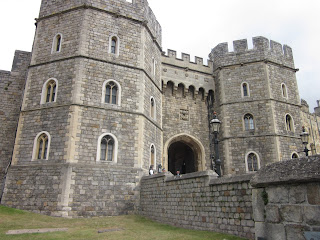Windsor Castle’s history is incredible. Having been
built in the 1070s by William the Conqueror, it is looked after even to this
day. Monarchs still visit, even if it is typically only twice a year (for
Easter and in June) at least. Yet the most obvious fact about the castle is
that those who ruled wanted to add a bit of themselves to the castle before
death. That is how they chose to uphold their legacy. This legacy is based
under St. George, the patron saint of England. He stands for bravery and honor,
which is an understandable patron to place a castle under.
Examples of the legacy going back to St. George and
his representation are found in all the reconstructions and additions in the
architecture. During the Renaissance, we have in the 1360s, Edward the III. He
created the addition of St. George Hall for his Knights of the newly founded
Order of the Garter. Crest for the order is based off of St. George’s symbol of
a red cross on a white background with a garter encircling it. The Order of the
Garter is specifically for those deemed honorable and worthy of the title of a
knight from the Monarch themselves. Edward IV continued this when he started
the creation of St. George’s Chapel, despite it needed to be completed by Henry
VIII. These were specifically done, but at some point the Monarchs, I believe,
felt compelled to make additions because previous monarchs had done the same.
It is stated in a Windsor Guide that Henry VIII also rebuilt the gate in the
Lower Ward. Edward IV began, but then Mary I finished the installation of a
fountain in middle of the Upper Ward by getting water from the Black Moor Park.
Elizabeth I also made a terrace-walk to the North of the castle.
The biggest bump in the castle’s history during the
Renaissance is in 1642. Oliver Cromwell commandeered the castle after the
Battle of Edgehill during the English Civil War which was the Monarchy versus
Parliament. Charles I tried to get rid of Parliament, but that did not work out
favorably for him. Though it was almost smoothed out at one point, he then
tried to get rid of five Parliament members, causing problems to arise again. But
when it comes to the castle, it became a headquarters for parliamentary forces
during the Civil War. Despite this rough patch where Charles was held captive
there before his trial and execution, Oliver Cromwell asked that the integrity
of the estate be left as it was for the most part.
This was all glanced over once Charles II took over
and began fixing up the castle in the 1670s. He created a new set of State
Apartments and took the place from a Gothic style to a Baroque style. It just
continues on and on with renovations and changes of styles because monarchs
just want to leave behind a legacy (one that is hopefully an honorable one).
One would never know that the castle was taken over and used for forces against
the monarchy at one point in history.



No comments:
Post a Comment